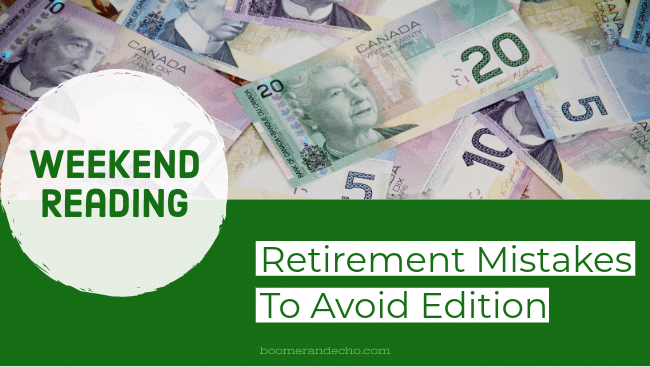Weekend Reading: Retirement Mistakes To Avoid Edition


Retirement is often put on a pedestal – the pinnacle of achievement after a decades-long career. But the transition from full-time work to full-time leisure can be challenging, both financially and psychologically, if you’re not prepared to meet them.
I’ve witnessed these challenges firsthand working with hundreds of retirees over the years. Here are four retirement mistakes to avoid:
1.) No Clue How Much You Spend
The most successful retirees I know have mapped out their spending plan well in advance of retirement. Rather than relying on rules of thumb, they tracked their spending in the years leading up to retirement to identify their true cost of living.
They’re not necessarily focused on hitting a certain portfolio milestone because they know it’s their spending that matters most. Who needs $2M if you only spend $50,000 per year?
This is one of the most critical pieces of your retirement plan. I often say that the best predictor of your future spending is what you’re spending today.
Indeed, most of my retired clients want to maintain their current standard of living, if not enhance it if they can with additional spending on travel, hobbies, and helping out their kids and grandkids.
Once you have a good sense of your desired spending you can determine which accounts to draw from, when to take government benefits, and how to fit all of your retirement income puzzle pieces together in a tax-efficient way. But it always starts with your spending.
2.) Not Considering One-Time Costs
Okay, so you’ve figured out your desired annual spending needs. But life doesn’t move in a straight-line.
Over a 30+ year retirement you can certainly expect to replace a vehicle, renovate or repair parts of your home, offer financial assistance to your children (post-secondary, wedding, house purchase, etc.), or take your own bucket list trip.
Some of these expenses can converge all at once during your earliest retirement years. You buy a new car, renovate the kitchen or backyard, take a dream vacation, and still pay your kids’ phone and auto insurance bills.
Many also find themselves paying out of pocket picking up prescriptions, mobility aids, in-home care, and groceries for their own aging parents.
Meanwhile, a poor sequence of investment returns can wreak havoc on your retirement nest egg at the worst possible time – while you were counting on significant withdrawals.
Don’t go into retirement blind to these realities. Consider a 3-5 year plan of one-time costs and how you’ll fund these expenses. Ideally, take care of some of them in your final working years. Set aside a bucket of cash from which you can draw for lump sum expenses or emergencies.
3.) Not Switching From Saving to Spending Mode
This is a two-part issue. One, aggressive investors are often still focused on achieving the highest rate of return in retirement. They’re chasing stocks, concentrating investments in smaller niches, and ignoring that they’ve basically already won the game.
Now I’m not suggesting you need to sell all of your stocks in favour of bonds, GICs and cash. Not at all. I’m just saying to think more sensibly about diversifying away risks by investing more globally instead of concentrating on one country, sector, or a handful of individual companies.
The risks that got you here might have paid off, but you’re playing a different game now that you’re retired. The stakes are much higher, with less room for error.
Two, investors have a hard time turning off the savings taps and turning on the spending taps. I’ve worked with retirees who have no plans to stop contributing to their TFSAs throughout retirement.
Hey, if you don’t need that money to fund your lifestyle, you want an extra margin of safety for potential poor health outcomes in your final years, or you want to leave a large inheritance to your kids then I say go for it – keep funnelling money into your TFSAs until you die!
But some retirees take this too far. They forgo vacations because they’d prefer to make TFSA contributions. Discussions around RRSP or RRIF withdrawals are often about where else to invest those funds (TFSA, non-registered investments) instead of using the funds to meet desired spending needs.
Retirement shouldn’t just be a shell game of moving money from one account to another. Ideally, you’re using your available resources to maximize your life enjoyment. Isn’t that what you saved for in the first place?
4.) Not Considering Your Home Equity Release Strategy
Most Canadian homeowners have seen an unprecedented rise in property values over the last 20 years.

It’s likely that your home is your largest asset in retirement, if not a close second. But you can’t eat your cupboards, so unless you have a plan to tap into that unproductive home equity you may end up living a smaller lifestyle than you’d like to in retirement.
For many Canadians who lack retirement savings, downsizing (or selling and renting) is the most obvious solution. You can add hundreds of thousands of dollars back into your savings pool that can be used to maintain your desired standard of living, or at least prolong it for several more years.
Even if it’s not necessary to tap into home equity to maintain your standard of living, for health reasons it simply may not be practical to remain in your home indefinitely.
A paid-off home is a nice back-stop to have for your later years, but selling earlier should not be overlooked if it would lead to a drastically improved retirement outlook.
This Week’s Recap:
An important piece on the pitfalls of leaving your advisor to invest on your own. Yes, you can slash your investment fees to the bone. But you need to be able to stick with your investment plan, and seek out professional advice at key life stages.
A look at two types of overconfident investors and how they can self-sabotage their portfolios.
My latest for MoneySense: You’ve reached your 40s, are mid-way in your career and realize you’ll never have a pension. Here’s how to get ready for retirement.
Promo of the Week:
Many of you took advantage of Wealthsimple’s 1% transfer bonus promotion this summer. That promo has ended, but you can still take advantage of Wealthsimple’s zero-commission trading platform and they’ll reimburse any transfer-out fees (typically $150 per account) if you move $15,000 or more.
I’ve almost fully converted to Wealthsimple, starting with my RRSP and TFSA several years ago, and my LIRA earlier this year.
The in-kind transfer from TD Direct to Wealthsimple was completed in three business days.
The platform is so easy to use. Set up recurring contributions AND purchases of your favourite ETF right from the mobile app. You can also turn the dividend reinvestment feature on or off with a simple tap.
Generation clients (individuals or households with more than $500,000 in assets) enjoy other perks like a 4.25% interest rate on their Wealthsimple Cash savings account, 10 airport lounge passes, priority support, and a host of other benefits.
Use my referral code: FWWPDW and open your Wealthsimple account today.
I’ve been told the addition of RESPs and corporate investing accounts are coming to the Wealthsimple Trade platform soon. Once added, I’ll move my corporate account from Questrade and my kids’ RESP from TD Direct.
Canada is in the midst of the greatest wealth transfer of all time, as some $1 trillion passes from boomers to their millennial kids.
Seniors’ scams are on the rise. Some advice – don’t pick up the phone.
Here’s Jason Heath on which types of pension income can be split with your spouse in retirement.
Michael James with an honest review of The Canadian’s Guide to Investing:
“The authors would need to put extensive work into this book to bring it up to date. As it is, I can’t recommend it to others.”
The Globe and Mail’s Erica Alini says that fixed mortgage rates of below 4% are being spotted in Canada for the first time in years.
Dr. Bonnie-Jeanne MacDonald and Doug Chandler are doing the lord’s work, tackling misconceptions around the decision to claim CPP early. Their latest research looks at the common narrative around taking CPP early to invest on your own.
“It concluded that holding on to RRSPs savings, instead of using them to finance a delay in receiving CPP/QPP benefits, carries more risk and less reward.”
A Wealth of Common Sense blogger Ben Carlson shares the success rate of the popular 60/40 balanced portfolio over the last 100 years or so.
Finally, Canadian seniors are wealthier than ever. Is it time to do away with the seniors’ discount?
Have a great weekend, everyone!





